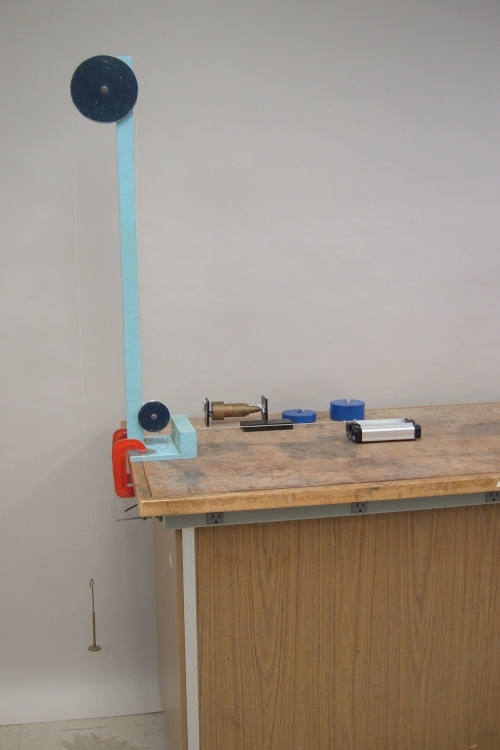
At one end of a string hung over a pulley system, is a mass. The other end of the string is attached to a cart. If you pull the cart away from the pulley stand, and then release it, the cart is accelerated toward the stand by the tension in the string produced by the weight of the mass hanger. You can increase the rate at which the cart accelerates, by hanging larger masses. The cart has two iron bars, which fit into a cavity in the top face of the cart. By placing one or both of these in the cart, you can increase its mass, and thus decrease its acceleration for a given hanging mass. If you wish, you can add even more mass to the cart by placing one (or both) of the blue masses on it.
In this demonstration, a string that goes over a pulley system has a mass hanging at one end, and a small cart attached at the other end. At its end of the string, the mass exerts its weight (= mg, where m is the mass, and g is the acceleration of gravity). The tension thus produced in the string exerts a force on the cart attached at its other end, thus accelerating the cart toward the pulley stand. The tension in the string is the same over the entire length of the string, and equals the difference between the weight of the mass, and the acceleration of the cart. That is, if we call the tension T, the mass of the cart M, the mass at the end of the string m and the acceleration of the cart (and of the hanging mass, which equals it) a, then T = mg - ma, and T = Ma (or m(g - a) = Ma). Thus, the greater the tension in the string, the greater the force applied to the cart, and the greater the acceleration of the cart. This demonstration thus illustrates Newton’s second law of motion, which (as quoted in Sears, Francis Weston and Zemansky, Mark W. College Physics, Third Edition (Reading, Massachusetts: Addison-Wesley Publishing Company, 1960), p. 78) states, The change of motion is proportional to the motive force impressed; and is made in the direction of the straight line in which that force is impressed. If we take “change of motion” to mean the rate of change of velocity, or an acceleration, and remember that an object’s inertia is proportional to its mass, we end up with the familiar F = ma.
The cart has two iron bars, which you can place in a cavity in its top face. Each bar has about the same mass as the cart (~500 g), so you can double, and then triple, the mass of the cart by adding them one at a time. You can thus change the inertia of the cart, and so change the acceleration that results from a particular applied force. As noted above, if you wish, you can also place one (or both) of the blue masses on the cart. (One has a mass of 1 kg, and the other has a mass of 2 kg.) You can, of course, also change how much mass hangs from the other end of the string, and either increase or decrease the tension by, respectively, increasing or decreasing the size of the hanging mass.
It is interesting to note two special cases regarding the relationship between the size of the hanging mass and the mass of the cart. If the mass of the cart is much greater than that of the hanging mass, M ≫ m, then a becomes very small, and T ≈ mg. If the mass hanging from the end of the string is much greater than that of the cart, m ≫ M, then a approaches g. T ≈ Mg, and the hanging mass is nearly in free fall.